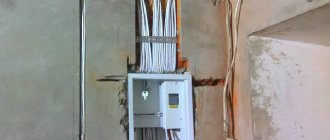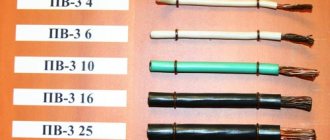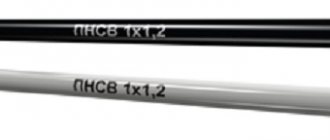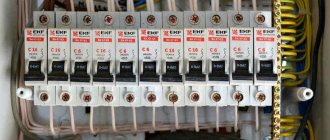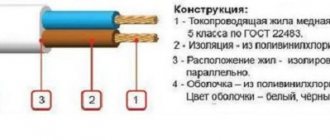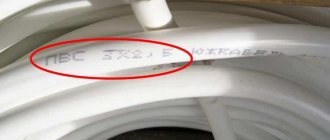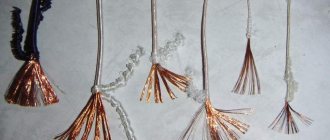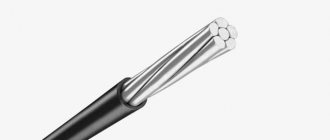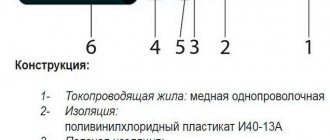Every owner of a car, garage or private home always tries to use the best wires in his electrical network, especially if it is necessary to transmit high current reliably and with minimal losses. The PV 3 wire was created precisely for these purposes. It acquired its designation back in the USSR, made in accordance with GOST 6323-79.
Today, PV-3 is still produced in modern factories according to the new GOST 31947-2012 and has its second name PuGV , but not only the name has changed, the conductors themselves have become more flexible, reliable and durable. learn more about the characteristics, main differences in colors, where you can buy them and much more from our article.
What does PV on the wire mean, decoding
According to the no longer valid GOST 6323-79, wires are marked by letter and color designations, the letter values are deciphered as follows:
- Letter P - wire
- Letter B – vinyl (polyvinyl chloride), insulation
- Number 3 – flexibility class from 1 to 6. (As the number increases, flexibility increases, pv1 has one core , and accordingly has the least flexibility)
For example, PV-3 1x0.75-0.38 says that this is a flexible wire in vinyl insulation, having one core with a cross-sectional area of 0.75 mm², capable of passing through itself up to 0.38 kV of electricity, for PuGV it is similar. Since this is a single-core wire, it is often designated as follows - PV-3-5 , this also means that it has one core with an area of 5 mm² (number 0.75, 1.5, 2.5, 3, 5, etc.) d – nominal cross-section, different for each wire, see table below).
Important! PV single-core, multi-core version of the wire is called PVS, PUGNP/PUGSP
According to GOST 31947-2012
- Letters PU – installation wire
- G – flexible
- B – vinyl or polyvinyl chloride, respectively
(PV, PuGV, puv same thing)
Fig. 1 – Explanation of wire designation
PV and PuGV wires according to the new GOST is that it cannot be used for installation work; its use is only possible in electrical installations.
Important! The main difference between PV 6 and PV 3 is increased flexibility, which is achieved due to a larger amount of copper wire in the cable cross-section. of the same cross-section are absolutely equal in conductivity. The resistance of thin-wire conductors nb 6 is slightly less, and accordingly there are fewer losses in the transmission of electricity.
The production of fine-wire products is more expensive than conventional ones, so the difference is also in cost.
Copper wire PV-3 or PuGV with a cross section of 1.5 2.5 and 4.0 mm2
find out the price
Copper flexible wire PV-3 is used for installation of lighting and power electrical networks; it is also widely used when connecting electrical installations, electrical equipment, various machines and production machines. In fact, the scope of application of the PV-3 wire coincides with the scope of application of the similar PV-1. The only difference is that, due to its greater flexibility, it can be used in hard-to-reach places and is ideal for installing sections of electrical circuits where frequent and strong bends are expected due to its design features.
The wire can be connected with a rated voltage of up to 450 V with a frequency of up to 400 Hz or with a constant voltage of up to 1000 V. The installation wire is used for single installation; group installation is permitted only in external electrical installations and production premises, where only periodic presence of maintenance personnel is possible, while Passive fire protection must be used.
The design of wire PV-3 (PuGV) 1.5 2.5 and other sections is extremely simple. In the center there is a flexible copper conductor. At the same time, the core is not monolithic (like PV-1), but is made of a large number of wires with a diameter of approximately 0.3 mm each. These wires are twisted into a kind of rope - in the language of specialists it is called a “strand”. Its use is justified by the need to make the wire flexible. All this is covered with ordinary PVC plastic, widely used in the cable industry, to isolate the wire from the environment. It is worth noting that using a strand also has a number of disadvantages, namely, it is inconvenient to attach it to devices and clamp it into terminals. According to the new standard, the PV-3 wire received a new name - PuGV. In principle, these two types of wires are identical in their main indicators and differ only in their flexibility class.
| Technical characteristics of wire PuGV (PV-3) | |
| Permissible operating temperature | from -50°С to +70°С |
| Permissible relative air humidity at temperatures up to +35°C | up to 100% |
| Laying and installation of cables without preheating is carried out at a temperature | not lower than -15°С |
| Resistance to mechanical shock, linear acceleration, bending, vibration loads, acoustic noise, mold fungi | persistent |
| Propagation of combustion on a single gasket | does not distribute |
| Minimum bending radius when laying | at least 5D wires |
| Life time | 5 years |
Our factory offers this installation wire of its own production on very favorable terms. Also, by calling us, you can order wire PV-3 (PuGV) 1.5 2.5 and other manufacturers. You can find the prices we offer in the corresponding section of the site.
From the dealer: Grundfos Hydro MX pump. But the pump is for increasing pressure. From the dealer: Grundfos Hydro MX pump. But the pump is for increasing pressure. From the dealer: Grundfos Hydro MX pump. But the pump is for increasing pressure. From the dealer: Grundfos Hydro MX pump. But the pump is for increasing pressure.
PV 3 cable design, color marking
The design of the wire is quite simple (see the article “Colors of wires in a three-core cable”). The wire core consists of twisted thin copper wire wrapped in colored polyvinyl chloride insulation. Depending on the purpose, different colors are used:
- blue, cyan – neutral/zero
- yellow, yellow with green stripes – ground/earth
- black, white, red, brown, any color except blue and yellow – phase
The greater the amount of copper wire in the conductor, the more flexible the conductor. PV-6 is more flexible than PV 3.
Technical characteristics of wire PV 3 (Table), how to check and choose correctly
When choosing, you must first of all be guided by the characteristics of the cable; PV-3 has the following parameters:
- maximum length – depending on the purpose, limited to 100m
- resistance of the insulating layer – 2.25 – 13 kOhm/km
- core material – copper
- installation temperature – -15°C
- working temp. – -50 – +35gr.С
- minimum service life is 15 years. Actual up to 50 years.
- Elongation – up to 50%
- Heat resistance – up to 150°C (short-term)
- Conductivity – depending on diameter (see table below)
Table - technical characteristics of PV 3 wire (diameter, mass - weight, core and insulation resistance)
| Nominal cross-section pvz (mm²) | Number of wires (pcs) | Outer diameter(mm) | Maximum electrical resistance in accordance with GOST 22483 (Ohm/km) no more | Reference mass/weight of 1km wire, (kg) | Electrical insulation resistance, kOhm/km, at +70°C, not less |
| PV 3 | |||||
| 1x0.5 | 7 | 2,1 | 39,5 | 8 | 13 |
| 1x0.75 | 7 | 2,3 | 25,6 | 11 | 11 |
| 1x1.0 | 7 | 2,5 | 21,7 | 14 | 10 |
| 1x1.5 | 7 | 3,1 | 14,1 | 21 | 10 |
| 1x2.5 | 19 | 3,7 | 8,01 | 34 | 9 |
| 1x4.0 | 19 | 4,3 | 4,8 | 49 | 7 |
| 1x6.0 | 19 | 4,7 | 3,1 | 70 | 6 |
| 1x10 | 49 | 6,5 | 2 | 116 | 5,6 |
| 1x16 | 49 | 8,1 | 1,2 | 182 | 4,6 |
| 1x25 | 65 | 10,5 | 0,81 | 272 | 4,4 |
| 1x35 | 105 | 11,4 | 0,55 | 365 | 3,8 |
| 1x50 | 144 | 13,3 | 0,4 | 540 | 3,7 |
| 1x70 | 210 | 15 | 0,28 | 706 | 3,2 |
| 1x95 | 285 | 18,1 | 0,21 | 1004 | 2,9 |
| 1x120 | 360 | 19,5 | 0,163 | 1245 | 2,7 |
| 1x150 | 444 | 21,2 | 0,128 | 1410 | 2,4 |
| 1x185 | 555 | 23,8 | 0,105 | 1650 | 2,25 |
more in GOST 22483 “Current-carrying conductors for cables, wires and cords” - link to GOST
Table 2 - maximum permissible current for wire Pv-3 (at voltage 220 V)
| One wire Pv 3 | ||
| Section mm² | Core diameter, mm | Power/current (kW/A, ampere) |
| 0,5 | 0,79 | 2,2/10 |
| 0,75 | 0,97 | 2,86/13 |
| 1 | 1,13 | 3,3/15 |
| 1,5 | 1,38 | 4,4/20 |
| 2,5 | 1,78 | 5,94/27 |
| 4 | 2,25 | 7,92/36 |
| 6 | 2,76 | 10,12/46 |
| 10 | 3,57 | 15,4/70 |
| 16 | 4,51 | 19,8/90 |
| 25 | 5,64 | 27,5/125 |
| 35 | 6,67 | 33/150 |
| 50 | 7,98 | 41,8/190 |
| 70 | 9,44 | 52,8/240 |
| 95 | 11 | 63,8/290 |
| 120 | 12,36 | 74,8/340 |
| 150 | 14,2 | 85,6/390 |
| 185 | 15,34 | 93,1/450 |
Important points when checking in a store
- Pay attention to whether the wire is made according to GOST or TU; GOST is preferable because TU is set by the manufacturer; there may be deviations in parameters from the standard.
- There must be a label on the packaging and markings on the cable itself
- Read reviews, choose only trusted manufacturers (about manufacturers , see below ↓ )
Important! Although this does not happen often, defects sometimes occur, especially if the product is Chinese. Before purchasing, be sure to look at the description on the package, pay attention to the cross-sectional diameter of the core, take a caliper with you to measure the diameter of the copper wire mm², count the number of wires.
Technical characteristics of wire PV 3 1x6
The main technical characteristic of a wire is considered to be the maximum voltage. For PV3 1×6 it is:
- 450 V at 400 Hz;
- 1000 V when using a DC cable.
What does a PVZ 1x6 grounding cable look like?
Please note! Resistance directly depends on the cross-sectional area. If we talk about PV3 1×6, then the cable resistance is 3.6 Ohm/km with a kilometer of material weighing 74.2 kg.
The cable can withstand a current of about 41 A and is capable of operating at temperatures from −60 °C to 60 °C, and is not afraid of exposure to steam. But it has many more restrictions.
The material cannot be laid in walls and screeds, since vinyl protection does not protect the cable from mechanical damage. Ultraviolet radiation is contraindicated for the material. Laying wires outdoors is prohibited by existing regulatory documentation. Vinyl decomposes when exposed to sunlight.
Specifications
For your information! PV-3 is the old name of GOST, left over from the USSR. GOST has been updated. Thus, GOST 6323-79 turned into GOST R 53768-2010, and the cable changed its name from PV-3 to PuGV. This is the same wire.
The main advantages and disadvantages of PV-3 cable
Like all conductors, PV3 has a number of advantages over others, but unfortunately, it is not without its drawbacks.
pros
- flexibility due to the large number of wires
- resistance to the external environment due to vinyl insulation
- large diameter wire, over 15mm², can be used in car audio systems; PV-6 from the company zandz (zz)
- infusibility
- low price
- thinner insulation, and therefore its own weight (see table above)
Minuses
- With aging, the insulation becomes more rigid
- when applying high current, the conductive wires in the core may burn out
- with frequent bending, tears of individual veins are possible
Where are PV brand wires used? Can they be used in cars for sound?
Due to the large number of current-carrying wires in the conductor cross-section, PV-3 (PUgV) have proven themselves well in moving elements of electrical installations, especially where increased flexibility is required, they are used literally everywhere:
- in everyday life - when laying in an apartment, house, garage, use as portable and temporary connections, extension cords (carriers), grounding
- in industry - special. equipment, moving consumers in workshops, powerful current consumers, in outdoor installations pvz are especially good to use
- for power lines - with a frequency of up to 400 Hz, communication lines
- for audio systems - for example, as power cables for car audio in a car. For such purposes, wires with a cross section of 1x25mm², 50mm², 70mm² are well suited, depending on the power of the installation. With the correct selection of the cross-section, you can get a high-quality and stable acoustic system. wire from the Zendz or Pride company is capable of transmitting up to 290A of current, let alone 70mm². Please note that in order to transmit such a powerful current without loss or interference, the ends of the wire must be crimped with lugs (sleeved) - more details.
PV 3 for sound into a car 50mm2
Application area of the wire
The cable markings cover a fairly wide range of applications. The wire can be used for laying wiring, connecting electrical appliances, power networks and automation.
However, it is not advisable to use PG3 for power cables. Two-core and stranded wires are much better suited (depending on the number of phases of alternating current, i.e., a two-core wire is convenient to use for laying two-phase power lines). For wiring in a house or apartment, wires with more sophisticated insulation that protect the cable from mechanical damage are much better suited. In addition, there are models of materials that serve perfectly as screeds.
Copper conductors
The big disadvantage of using cable in home wiring is the risk of burnout if the load is too heavy. It will not cause a fire, but it will easily ruin the fruits of the work of electricians in equipping the home.
But this is not a reason to put a cross on the wire. After all, for some reason they are still releasing it. PV3 has found the widest application in automation. Thus, it is often used in fire extinguishing systems. The wire is indispensable in automation systems of boiler rooms, ventilation, and car power supply.
Using PV3 in the automation panel of a ventilation unit
Note! PV3 is often used in domestic brands of cars and when repairing door locking elements, power supply to interior lamps and dashboard. In this regard, the wire compares favorably with foreign analogues, which are several times more expensive.
It is in car automation and power supply systems that the main property of wire is used - flexibility. With a huge number of wires and technologically important design details, the wire easily passes through any bends, connecting different models together.
If the load on the automation system is too high, the wire burns out, which triggers the alarm. Just what you need for fire alarm systems and any other automation.
Table of technical characteristics of PV cables
During home repairs, the wire is ideal for arranging grounding. You can ground the panel of a private house or any part of the apartment without any problems using any cable, but PV3 is inexpensive. At the same time, the model will do an excellent job of removing stray currents.
You may be interested in this Grounding wire
Where to buy PV-3 wire: manufacturers, prices
Today there are a large number of companies on the market - manufacturers of wires of various brands, producing high-quality wire products in a wide range at the best prices. There are even more intermediary companies, especially on the Internet, for example, the ETM company (not advertising).
There are a huge number of places to buy, so first of all, pay attention to the manufacturer. The following Russian companies are considered among the industry leaders: Energokabel, TD Alliance Cable, NKZ Elektrokabel NN, Spetskabel, ROSSKAT, ALUR Cable Plant, Moskabelmet.
The foreign companies that distinguished themselves were Zandz (ZZ), which produces lightning protection, grounding, and Pride. They are usually sold by the meter, prices vary greatly depending on the brand and section. For example, PV3 1x0.75mm costs on average 4-5 rubles/m, the price of PV3 1 x 2.5mm for a heated floor is already 20rub/m, and PV3-150 is 959 rubles per meter.
GOST for electrical wires
- GOST 6323-79 (ST SEV 587-87) “Wires with polyvinyl chloride insulation for electrical installations”
- GOST 31947-2012 “Wires and cables for electrical installations for rated voltage up to 450/750V inclusive”
- GOST 22483-2012 “Current-carrying conductors for cables, wires and cords”
